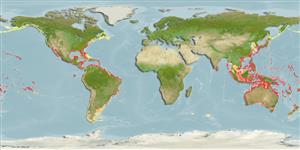Common names from other countries
Classification / Names / Names
Populärnamn | synonymer | Catalog of Fishes (gen., sp.) | ITIS | CoL | WoRMS
Environment: milieu / climate zone / depth range / distribution range
Ekologi
Revassocierade; djupintervall 0 - 55 m (Ref. 109199). Tropical
Western Atlantic and Indo-Pacific: South America.
Length at first maturity / Size / Vikt / Age
Maturity: Lm ? range ? - ? cm
Forms erect, branching colonies with flexible stems. Polyps have eight white frilly tentacles, hence the name snowflake coral.
Shallow water octocoral (Ref. 808), usually in turbid coastal areas (Ref. 1010998). On bay and nearshore (Ref. 109199). At depths of 1.5 to 8 m on coral reefs and rocky bottoms (Ref. 83916). Occurs on shaded clear waters where currents are strong (Ref. 101098). Common in the fouling community of harbors, on piers or wrecks (Ref. 415, 101098) which are not exposed to sunlight (Ref. 415)
Life cycle and mating behavior
Könsmognad | Reproduktion | Lek | Ägg | Fecundity | Larver
Members of the class Anthozoa are either gonochoric or hermaphroditic. Mature gametes are shed into the coelenteron and spawned through the mouth. Life cycle: The zygote develops into a planktonic planula larva. Metamorphosis begins with early morphogenesis of tentacles, septa and pharynx before larval settlement on the aboral end.
Collin, R., M.C. Díaz, J. Norenburg, R.M. Rocha, J.A. Sánchez, M. Schulze, A. Schwartz and A. Valdés. 2005. (Ref. 415)
IUCN Red List Status (Ref. 130435)
CITES status (Ref. 108899)
Not Evaluated
Not Evaluated
Threat to humans
Harmless
Human uses
| FishSource |
Verktyg
Ytterligare information
Age/SizeTillväxtLength-weightLength-lengthMorfologiLarverAbundans
Internet-källor
Estimates based on models
Preferred temperature
(Ref.
115969): 8.6 - 29, mean 26.1 (based on 2468 cells).
Price category
Unknown.
